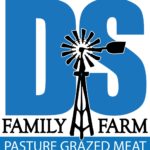Worried about what you are "really" eating? Have peace of mind with pasture grazed meats.
Pray for rain?
Grass farmers keep tabs on rainfall because grass growth tends to track well with the amount of rain a pasture receives. We have been told the amount of soil moisture you have at the beginning of the water year (October 1) is a good indicator of how grass growth will start off the following growing season. In our part of Nebraska, last October 1, we had some soil moisture but overall, we were dry and remain dry! What has happened since October 1, 2022? Here are a few interesting rainfall summaries for our area:
The above map from comes from the Drought section of PRISM Climate Group. Since the beginning of the Water Year we are in an area that has received 30% to 50% of “normal” or “average” Precipitation. Does that mean we will only grow 50% of the amount of grass we normally produce?
The chart above displays the last 100 years of precipitation records for October through April. There are only 14 years during the past 100 years that have been drier for this time period (Oct. – Apr.) in our County. We have been grazing our pastures since 2011, so this is obviously uncharted territory for us, usually we have had at least 4 more inches of rainfall by this time of year to work with. This chart is very easy to make for your County by visiting the NOAA website.
Current Soil Moisture
While planting some trees this past week, maybe not the best thing to do during a drought, we found some soil moisture. Much of the property looks green. We do believe that our past management is paying off entering a second growing season with less than ideal moisture conditions. Why do we have some soil moisture and why do the pastures look green? We guess it is based on the following main points:
- Holistic Planned Grazing
- Reduction in herd size starting April 2022
- Leaving appropriate soil cover
- Warm season grass pastures
Warm Season Grasses
Our pastures are predominantly warm season grasses. These are native prairie grasses such as Big Bluestem, Little Bluestem, Indiangrass, Switchgrass and Eastern Gamagrass. These are also known as C4 plants, which thrive when it is hot and dry. These native grasses are just now starting to take off and will begin to use the available soil moisture. The warm season grasses have bought us some time in hope of receiving some early summer rains.
Cool Season Grasses
Our pastures do contain some cool season native grasses and primarily two invasive cool season grasses; Smooth Bromegrass, and Reed Canarygrass. Over the past few weeks, we have heavily utilized reed canary grass in our sub irrigated land (which does have some good soil moisture). Smooth brome invades upland native grass pastures and is highly palatable (cows love it). Usually this time of year, smooth brome is a couple feet tall and we are happy to graze it while waiting for our warm season grasses to take off. The upland cool season grasses appear to be producing about half (50%) than what we would expect for a typical spring grazing season.
We are happy that our pastures look green and pleased with this amount of growth on our cool season grasses as neighbors have told us they only expect about 25% of typical growth on their predominantly solid stands of smooth brome.
Pray for Grass?
We have been praying for rain but not receiving much rain. The largest rain event recently has been a quarter of an inch, and we were grateful for that. In spite of the lack of rain, God has blessed us with grass and the opportunity to adjust our operation for what appears to be another below average year of grass growth. So maybe we should be praying for more grass rather than rain… cows eat grass, not rain.
Looking for more information on drought forecasting, check out the many resources at the “U.S. Drought Monitor“:
https://droughtmonitor.unl.edu/CurrentMap.aspx
We also like the Vegetation Drought Response Index (VegDRI).








